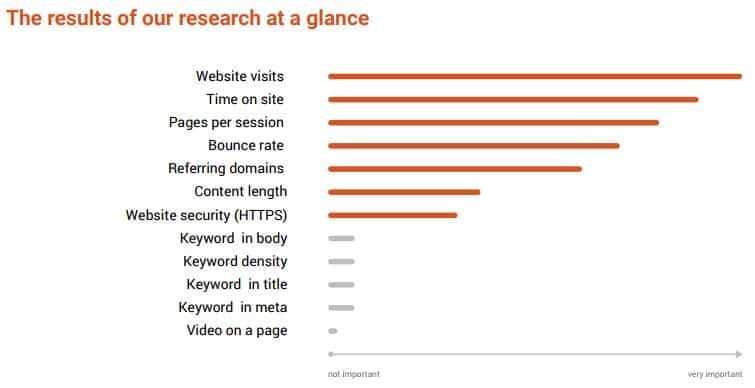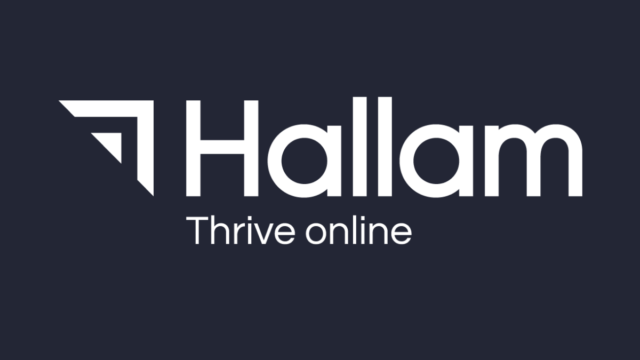In fact, what is good for UX is usually also a boost to your SEO efforts, and vice versa. Here, I’ll run through the key ways UX and SEO have a mutually beneficial relationship, but also highlight those potential occasions when a balance needs to be struck between UX needs and SEO needs.
Why is an excellent user experience so important for SEO?
Google wants to provide the best, most relevant results for its users. Since Google introduced RankBrain in 2015, the emphasis has been less on “traditional” ranking factors, and more and more on the post-click metrics related to your web pages – dwell time, bounce rate, and also the click-through rates from the search results to your website. RankBrain helps Google to determine the relevancy of content for search, and whether users are finding your content valuable, with Google then able to push your site up or down the rankings accordingly.

This is backed up by a ranking factor study carried out by SEMrush in 2017, with the results illustrating Google’s attempt to rely more on user data and less on on-page factors and links; helping to drive home the fact that better performance in Google depends heavily on improving your website visitors’ satisfaction.

The key point being, if a user doesn’t find what they are looking for quickly and easily, then site abandonment is likely, which will, of course, affect your conversion rates, but will also be taken into account by Google when ranking your website.
Key UX considerations which also benefit SEO
- Site navigation
Good UX design will ensure that a website is well organised and categorised, ensuring that it is as easy as possible for users to navigate on both mobile and desktop. With a clear and well-executed information architecture in place, this also makes it easy for a search engine algorithm to understand what each main and sub-section of a website is about, and how they relate to each other.
- Targeting audience personas
The first place to start when designing a website is with your audience, and this is also the case for defining your SEO strategy. By defining strong audience personas at the start of your website project, you can ensure your site is delivering in terms of their needs, challenges and frustrations. From an SEO standpoint, the main aim of keyword research and creating a site taxonomy is to map the intent of your target audience to your website experience – ensuring that you create content that matches the specific keywords and phrases that your target users are typing into Google. For example, someone searching for nutritional supplements may be seeking advice on benefits and the types of supplements to take based on their health issues or concerns. Then during the purchasing journey, he or she may also search for product comparisons, reviews, prices etc.
- Site speed and mobile experience
Fast page speeds and excellent experiences on mobile are imperative for both UX and SEO. Alongside the obvious benefits for the user, Google takes into account both with their ranking algorithm, especially since the introduction of the mobile-first index, which began rolling out in March 2018. Various studies over the year have shown that users will abandon pages that take too long to load, with one Google study finding that 53% of mobile site visits leave a page that takes longer than three seconds to load.
What are the potential tensions between UX and SEO?
While UX and SEO are essentially complementary disciplines, there are certain trade-offs or tensions that need to be navigated between the two.
- Page segmentation vs. consolidation
If we were only concerned about UX and not SEO, it may be that we could create a site with pages that create one singular experience, but for various different audiences or search intents. However, in a world where we need to balance both UX and SEO, we need to serve the different intents of people searching in Google with different pages, providing a better experience for searchers. For example, if we didn’t need to create pages to rank for keyword and phrases, one page on a website selling nutritional supplements for pets could have one main landing page covering all animals – cats, dogs, horses, perhaps using a filter function so the user can move between them. However, because we need to match different pages with specific search intent, the navigation must be segmented so we have separate pages for each. This can make things trickier for designers, if a huge number of pages needs to be created (think a large ecommerce store). However, it is imperative for SEO that these pages are created, so working closely alongside designers from the very beginning when developing a site taxonomy and navigation is hugely beneficial, so that everyone is on the same page.
- Keyword usage and crawler readable text
If we were only concerned with UX, we might create pages on a site that we want to rank in search for a purely visual experience, for example an interactive piece. However, if we know through our research that only pages with keyword-focused indexable text rank for our target topic, then from an SEO viewpoint, this would not be ideal. This is because we need to show searchers and search engines a page that is very relevant for a query and related keywords/topics – something that is not often possible with a piece of visual-only content.
So, we’ve considered the main UX and SEO considerations, the potential tensions, and how to strike a balance between the two. Driving traffic to your site, and driving conversions through your site are equally important, and one is pretty pointless without the other! Luckily, both UX and SEO often intertwine and work seamlessly together to provide an optimum experience for both users and Google.







